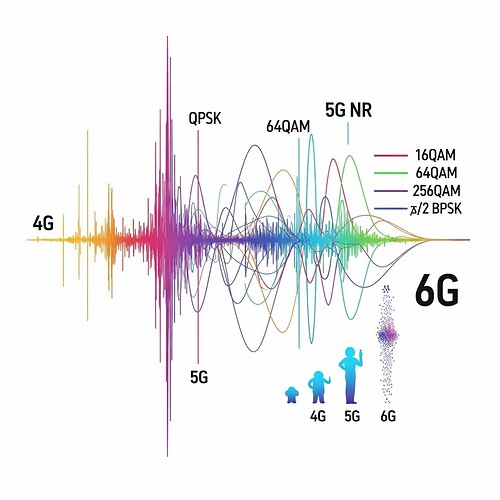From 4G’s QPSK to 6G’s AI-Driven Waveforms: The Journey of Efficient Bits
![]() What is Modulation?
What is Modulation?
Modulation maps digital data onto analog waveforms for over-the-air transmission. In 5G NR, this is done Resource Element (RE)-wise. A modulation symbol’s order defines how many bits each symbol carries:
• QPSK (2 bits/symbol),
• 16QAM (4),
• 64QAM (6),
• 256QAM (8).
![]() 3GPP 38.211 Reference:
3GPP 38.211 Reference:
Modulation is defined per channel—PUSCH, PDSCH, PUCCH, etc. Each uses a specific scheme depending on link conditions, UE capability, and network strategy.
Scheme Bits/Symbol Used In
π/2 BPSK 1 PUSCH, PUCCH Format 3/4
QPSK 2 PUSCH, PDSCH, PUCCH, PBCH, PDCCH
16QAM 4 PUSCH, PDSCH
64QAM 6 PUSCH, PDSCH
256QAM 8 PDSCH
![]() π/2 BPSK – The Unsung Hero
π/2 BPSK – The Unsung Hero
In poor coverage, π/2 BPSK shines with:
• ![]() Lower Peak-to-Average Power Ratio (PAPR),
Lower Peak-to-Average Power Ratio (PAPR),
• ![]() 90° rotation per symbol → avoids “zero-crossings”,
90° rotation per symbol → avoids “zero-crossings”,
• ![]() Better battery efficiency due to simpler amplifier operation.
Better battery efficiency due to simpler amplifier operation.
![]() Modulation Equation:
Modulation Equation:
For constellation-based modulations:
Bits per symbol = log_2(M)
Where M = number of constellation points (e.g., 256QAM → log_2(256) = 8 bits/symbol)
![]() From 4G to 5G to 6G: What Changed?
From 4G to 5G to 6G: What Changed?
• 4G LTE: Limited to QPSK, 16QAM, 64QAM.
• 5G NR: Adds 256QAM + π/2 BPSK + adaptive modulation + DFT-s-OFDM in uplink.
• 6G (evolving): Introduces Reconfigurable Intelligent Surfaces (RIS), AI-driven adaptive modulation, sub-THz frequencies—modulation becomes environment-aware!
![]() Code Insight (Python-based Constellation Visualisation):
Code Insight (Python-based Constellation Visualisation):
import numpy as np
import matplotlib.pyplot as plt
def qam_constellation(M):
m = int(np.sqrt(M))
x = np.arange(-m+1, m+1, 2)
X, Y = np.meshgrid(x, x)
plt.scatter(X.flatten(), Y.flatten())
plt.title(f’{M}-QAM Constellation’)
plt.grid(True)
plt.show()
qam_constellation(64) # Visualise 64QAM
![]() Real Use Case:
Real Use Case:
• Rural Coverage: π/2 BPSK → lower power, deeper penetration.
• Urban High Capacity: 256QAM → more bits, higher throughput.
![]() Takeaway:
Takeaway:
Modulation isn’t just math. It’s the language of connectivity, optimizing the tradeoff between robustness and data rate—from edge UEs in remote zones to 8K streaming in smart cities.
⸻
![]() Let’s decode complexity into curiosity!
Let’s decode complexity into curiosity!
LinkedIn: ![]()
